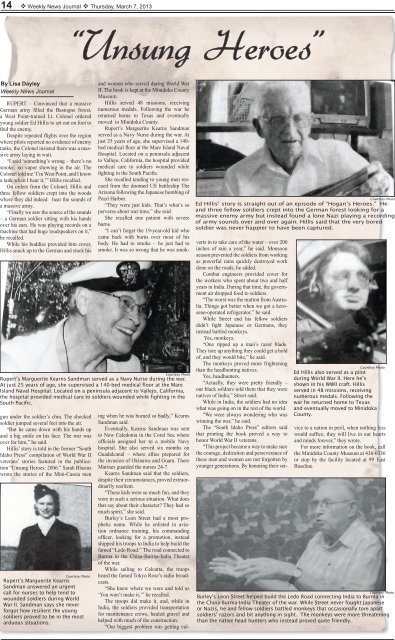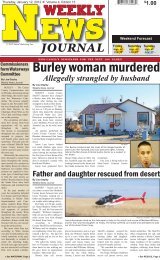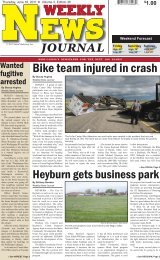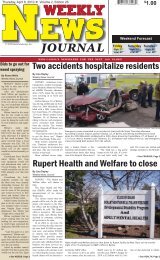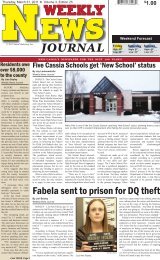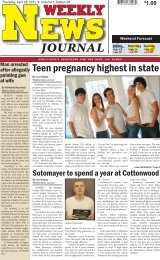12 Weekly <strong>News</strong> <strong>Journal</strong> Thursday, March 7, 2013Live LocalCommunity CalendarWeekly <strong>News</strong> <strong>Journal</strong> Thursday, March 7, 2013 13By Lisa DayleyWeekly <strong>News</strong> <strong>Journal</strong>Snake River Flats annual showBURLEY – The Snake Riverlats needs a few good men.With declining participaionover the past few years, theroup urges teenage boys 14 andp and men 18 and older to joints group. Currently the groups comprised of men ages 37o 88 years of age and it is curentlypushing a membershiprive to get more participationn the group that’s been a part ofhe Mini-Cassia community forearly half a century.“This will be our 45th anniersary,and we need moreembers. We only have six paidembers and that’s what makest so vital to get some new membersout or we’ll have to closeour doors. Under the society’srules, the district can close thechapter if they see us failing,”said member Aaron Clegg. TheFlats is part of a national andinternational barbershop organization.All that’s needed to join theFlats is a love of singing.“You don’t have to be a virtuoso.We can help them learn.We can sit down and teach them.We don’t expect them to be allknowing in music,” he said.In hopes of generating moreinterest in the group, the SnakeRiver Flats plans to host its annualconcert called “One More Time”this month. The event is scheduledat 7 p.m., Saturday, March16, at the King Fine Arts Center.Tickets are $8 for adults, $4 forstudents, and $6 for seniors and$20 for families.“It’s our one and only fundraiser. We’ll be doing ‘DannyBoy,’ ‘Armed Forces Melody’and a special number by LucyKnos called ‘Idaho.’ We have abroad spectrum,” Clegg said.The Salt Lake City-basedgroup “Reprise” headlines theevent just as they did in 2002.“They were fresh out of collegethen. They’re now a littlebit more seasoned. They’reassociated with the BarbershopSociety. They have a couple ofCDs out. They’re pretty good,”he said.Also participating will bethe Pocatello Gateway Chorus.White Pine fifth and sixth gradesingers plan to sing under thedirection of music teacher BonnieBair.The Snake River Flats practicesat 7:30 p.m., every Tuesdayat Harmony Hall (formerlythe cannery) at 123 K. Street. Itcosts adult full time membersCourtesy PhotoThe Snake River Flats will entertain with their concert “One More Time” scheduled at 7 p.m.,Friday, March 7, at the King Fine Arts Center. Tickets are $8 for general seating, $20 forfamilies, and $6 for seniors and $4 for students. The group, in danger of being dissolved dueto lack of membership, is actively seeking new singers.$151 for a year’s membership.Youth membership is about halfthat cost. Money from thosefunds goes toward funding variousbarbershop programs.Members sing one of fourparts: base, baritone, tenor andlead. They traditionally sing aform of song called a capella,meaning without any pianoaccompaniment.“We’ll ask ‘what part do youwant to try? Which one is in yourvoice range? We’ll see whereyou’re comfortable in singing,”he said.Professional music arrangersput together the Flats songs, butit’s not just what great-grandpamay have sung.“There’s one back east whoarranges a lot of the barbershopmusic into more modern stuff.There’s one who will arrangeanything. He’s does the BeachBoys’ songs. We have a catalogueof thousands of sheets ofmusic,” he said.Clegg has been singing sincehis Burley High School days andcontinued to do so while attendingthe former Ricks College.“What I like about singing isthat it helps me relieve stress fromwork. It’s the one night where Iget a little bit of a breather andhave some friendship. Our barbershopis a brotherhood. Wehave long term friendships witheach other. At practice we sing,we get serious, we joke, we geta little bit loose, we have fun,”he said.Anyone with an interest isstrongly encouraged to join thegroup.“If they think they soundpretty good in the shower, comeout and try. We need help,” hesaid.For more information on theupcoming concert and in joiningthe Snake River Flats call 300-0146 or 436-6047.Thur - Mar 7Thurs., March 7th, 10:30 and6:00 - Storytime “Jump, FrogJump”. Toddlers and pre-schoolersare invited to the library toshare books, rhyme, song and asimple craft. This program is freeand everyone is welcome to attend.Burley Public Library.Fri - Mar 8What Soil Are You? First ChristianPraise Chapel is hostingtheir annual women’s SpringAdvance, March 8 & 9. The Parableof the Four Soils with guestspeaker Rebecca Bauer. She isa Christian author, speaker andteacher (www.rebeccabauer.org).We hope that you can join us fora great time of fellowship drawingcloser to our Lord throughHis word. Registration Fee: $30prior to Feb. 28th, $35 after. Formore info, contact Kay Adams @431-8352 or 436-0449. Stayingin a hotel? Special rates @ theFairfield with code: PRAS.Friday, March 8th, 10:30 - Storytime“Jump, Frog Jump”. Toddlersand pre-schoolers are invitedto the library to share books,rhyme, song and a simple craft.This program is free and everyoneis welcome to attend. BurleyPublic Library.Footloose & Grease. Bel CantosChoir Dinner Show. March 8thand 9th. 6:30 pm at the King FineArts Center. $20.00 per ticket.Advanced ticket sales only. ContactCindy Hansen 878-6606 or670-4405.Sat - Mar 9cation in this area are invited toattend. Meetings, which are heldSeptember through May on thesecond Monday, are always entertainingand informative. Forfurther information, please callJean Hamblen, president, at 678-7755.Tues - Mar 12Tri-City Sports - Rupert, Heyburn& Paul. The Rupert Recreationis now taking registrationfor CO-ED Spring Soccer ages4-15. Registration dates Feb. 14to March 12. Price $16.00. AfterMarch 12 cost is $32.00. Gamesbegin in April. For more informationplease call 434-2400. Formsare at the City Halls of Rupert,Paul and Heyburn; Donnelleys oronline at Rupert-idaho.com (goto parks & rec. forms).Attention: Raft River GroundWater Users. A special meeting todiscuss the urgent water concernsof our district. Tuesday March 12,2013 7:00 pm at Raft River HighSchool Auditorium. Your input isvital to aid in the progress of ourwater district. Please attend.Thur - Mar 14Mar. 14, 15, 16, 21, 22, 23, 29, 29,30: Idaho Youth Ranch 33rd AnnualBasketball Tournament 2013. Grades5-8 Girls & 5-8 Boys. Contact TonyBell for information: 532-4117 or312-7099.Burley United Methodist Churchwill once again be holding LentenLunches from February 14ththrough March 21st from 12-1p.m. A light lunch is served anda different speaker will host theprogram each week. The lunchesare free to everyone and everyoneis welcome!ed to the library to share books,rhyme, song and a simple craft.This program is free and everyoneis welcome to attend. BurleyPublic Library.Inline Roller Hockey 2013.Boys & Girls, ages K-12. RegistrationFebruary 19 throughMarch 15. City Halls of Rupert,Paul, Heyburn, Burley and IdahoWater Sports. Cost is $25 perplayer. First year player cost isfree. Season Starts first week ofApril and ends mid May. Anyquestions call Boyd 260-1976,Steve 431-0899, Michelle 670-0211 or Maureen 431-0746.Sat - Mar 16St. Nicholas Church and Schoolare having their annual BasqueDinner and Auction on Saturday,March 16th, at the RupertElks. An authentic Basque dinnerwill be served from 6:00p.m. until 8:30 p.m. There willan auction, raffle and dancingincluded in the night’s activities.Our raffle includes$250.00 worth of gift cards ofyour choice along with manyother items. Wild Night will beproviding music after the auction.The price is $25.00 perperson and $10.00 for children12 and under. If not eating dinner,there will be a $5.00 covercharge. Please come join us fora fun filled evening.Lloyd Cox Center1226 Parke Ave. • BurleySun - Mar 17Burley United Methodist is hostingpianist/composer Mike Lemieux inconcert on March 17th at 2:00p.m.Audiences at Mike’s performancesdelight in the gently flowingrhythms, lush harmonies, and lyricalmelodies which are hallmarksof his style. An intimately expressiveperformer, he evokes the fullrange of emotion from each phrase,drawing listeners to join him on anever-evolving journey. Join us at450 East 27th Street in Burley for agreat afternoon of music!Wed - Mar 20The Mini-Cassia Service Providerswould like to invite all service relatedindividuals and businesses to attendour annual meeting on March 20that Conner’s Café. There is a no-hostlunch from 11:30 to 12:00. Presentationsbegin at noon. Please makeplans to come and find out what ishappening in your community. Feelfree to bring materials that you wouldlike to share with the group regardingyour organization or business. TheMini-Cassia Service Providers meetthe third Wednesday of each month atConnor’s Café at 11:30 for a no-hostlunch and presentations begin at noon.We look forward to seeing you there!Share a Little Luck: Run for a Causey Lisa Dayleyeekly <strong>News</strong> <strong>Journal</strong>BURLEY - The late LorraineMorgan loved kids.She loved them so muchthat she ran a daycare for yearswhere she encouraged her youngcharges to be physically activewhile at her facility.As a result, it’s only fitting tohonor Mrs. Morgan during thesecond annual “Share a LittleLuck: Run for a Cause.” Theevent is scheduled at 10 a.m.,Saturday, March 16, starting atBurley High School. It costs $20to enter and $25 on registrationday. Racers will receive a T-shirtand a coupon for a free drink atthe Chadwick Restaurant.Proceeds from the event gotoward funding the Oregon TrailRecreation District which Morganwould have supported, raceofficial Karen Thomas said.“Look at Lorraine’s place andhow active they had it out there.You go out there, and it’s like ‘oh,my gosh, this is a huge gym,” shesaid.The event includes both 5Kand 10K races. Participants forFile Photoit blew. It was typical southernIdaho weather,” Thomas said.Prizes will be awarded to first,second and third place winnersof the race. The Shuz Store inBoise is donating T-shirts andgift cards. Chadwick Restaurantis also providing gift certificates.Twin Falls-based Chobani’s hasdonated yogurt and Smith’s isproviding bananas.“We’ll have a little breakfastafterward and give awards out,”she said.Thomas emphasized that participantsneed not race.“People can bring their kids,push strollers, and kids can ridetheir bikes on the canal road. Ourtheme is ‘you can jig, meander,walk or run, be competitive ornot be competitive,’” she said.Thomas doesn’t like to run butloves to walk and then jog, walksome more and jog again.“I like to get outside and walk.I jog/walk. I’m not competitiveby any means. It doesn’t take alot of money to do that. Thoseare good things and good ways toexercise,” she said.While she doesn’t like to run,Thomas has participated in theactivity to welcome in thespring.“It’s fun to get outside, and it’snice to do things in the spring. Wepicked ‘Share a Little Luck’ to goalong with St. Patrick’s Day. Wekind of tied them all in together,”she said.Last year, the organizationhonored the late businessmanWendell McMurray. Proceedsfrom the event went to formerBurley High School dramateacher Richard Call, who atthe time was undergoing cancertreatments.The race is a way to pay it forwardand to honor someone whodid a lot for the community.“How many kids did Lorrainewatch and take care of? Parentsdidn’t have to worry about wherethe kids were after school,”Thomas said.Just as Mrs. Morgan did, theOregon Trail Recreation Programwill positively impact a lotof people. We really hope the recdistrict will help even more kidsget involved in activities. I thinkactivity stimulates your mind.It’s better for everybody. Look atLorraine’s place and how activeboth events start from the high school track. The 10K’ers will school.annual Turkey Trot, the Heart2Heartthey had it out there,” she said.chool, follow the canal, later continue down 200 South toward and the Minidoka Dam runs. Currently 120 people haveTo register for the event logoing south across Washington the Star LDS Ward heading registered for the race. Last year “I just like to get outside and on to http://www.eventbrite.com/treet near the ethanol plant. south on the canal toward DOT 250 entered and, despite terrible get some fresh air,” she said. event/5436422486# and for morerom there 5K racers will turnround and return to the highFoods. From there they’ll turnaround and head back to the highweather, continued with the race.“It snowed and it rained andOfficials opted to hold theevent in March to provide aninformation call 650-8069.(See related story on page 23.)Sat. March 9th, Mini-CassiaBusiness Bash. Free admission,door prizes. Business 10am-4pmand Bash 6pm to 10pm. Morey’sEvent Center 219 E 3rd St, Burley.For more info call Mandy at208-312-2987.3rd Annual Living for WellnessHealth Fair. Parke View Rehab.2303 Parke Ave., Burley. 677-3073. Saturday, March 9th, 11am to 3 pm. Free to the public.All ages, Food, Door Prizes, VendorBooths, Blood Pressures andGlucose Checks.Mon - Mar 11Mon., March 11th at 3:00 – DigitalScavenger Hunt. To celebrateNational Teen Tech Week, thelibrary is hosting a Digital ScavengerHunt for teens ages 13 to18. Teens will have a list of itemsto photograph, the list of itemswill all be found within walkingdistance of the library. Prizes andsnacks will be provided. Pleasecall 878-7708 for more details.Burley Public Library.The next meeting of the Mini-Cassia Retired Educators Associationwill be held at 11:00 a.m.on March 11th at Connors Caféin Heyburn. At our luncheonmeeting, attendees may order offthe menu and we will be entertainedwith a musical program byJim Hartwell and Glen Wilkinson.All those interested in edu-Thurs, March 14th, 10:30 and6:00 - Storytime “St. Patrick’sDay”. Toddlers and pre-schoolersare invited to the library to sharebooks, rhyme, song and a simplecraft. This program is free andeveryone is welcome to attend.Burley Public Library.Thurs, March 14th, 1:30 – AfternoonBook Club will discussthe book “The Art of Racing inthe Rain” by Garth Stein. Newmembers are always welcome toattend. Burley Public Library.Albion Seniors Annual PrimeRib Dinner. Reservation a must.Cut off date is Thursday, March14. The dinner is March 16. 5:00pm to 7:30 pm. Price is $13 perperson suggested donation. Takeout available. Dinner includesprime rib, baked potato, greensalad, rolls and cookie bar. CallMarcella 673-6624, Helen 673-6692. Albion Senior fundraiser,a great meal and great company!All donated proceeds go to AlbionSeniors.Fri - Mar 15Chicken Noodle Dinner. PaulUnited Methodist Church, 127West Clark St., Paul, Idaho. 208-438-5530, Friday, March 15th,5-7PM. Free will donation. Takeouts welcome. Homemade noodlesfor sale.Friday, March 15th, 10:30 - Storytime“St. Patrick’s Day”. Toddlersand pre-schoolers are invit-NEW SHIPMENT48 Pallets • Better QualityAcceptedCanned Food • Boxed Goods & MoreD.L. Evans Investment ServiceswelcomesDEE DARRINGTONInvestment RepresentativeMini-Cassia & Eastern Idaho Market AreasNorth Burley Branch397 N. Overland Ave.(208) 678-9076D. L. Evans Investment ServicesSecurities, insurance products and advisory services are offered through Cetera Investment Services LLC, member FINRA/SIPC. Cetera Investmentwith an appropriate Firm Advisory Services Agreement and disclosure brochure as provided.www.dlevans.com
14 Weekly <strong>News</strong> <strong>Journal</strong> Thursday, March 7, 2013“Unsung Heroes”By Lisa DayleyWeekly <strong>News</strong> <strong>Journal</strong>RUPERT – Convinced that a massiveGerman army filled the Bastogne forest,a West Point-trained Lt. Colonel orderedyoung soldier Ed Hillis to set out on foot tofind the enemy.Despite repeated flights over the regionwhere pilots reported no evidence of enemytanks, the Colonel insisted there was a massivearmy laying in wait.“I said ‘something’s wrong – there’s nosmoke; no vapor showing in the air. TheColonel told me ‘I’m West Point, and I knowa tank when I hear it,’” Hillis recalled.On orders from the Colonel, Hillis andthree fellow soldiers crept into the woodswhere they did indeed hear the sounds ofa massive army.“Finally we saw the source of the sounds– a German soldier sitting with his handsover his ears. He was playing records on amachine that had huge loudspeakers on it,”he recalled.While his buddies provided him cover,Hillis snuck up to the German and stuck hisgun under the soldier’s chin. The shockedsoldier jumped several feet into the air.“But he came down with his hands upand a big smile on his face. The war wasover for him,” he said.Hillis’ story is told in the former “SouthIdaho Press” compilation of World War IIveterans’ stories featured in the publication“Unsung Heroes: 2006.” Sarah Blasiuswrote the stories of the Mini-Cassia menCourtesy PhotoRupert’s Marguerite Kearns Sandman served as a Navy Nurse during the war.At just 25 years of age, she supervised a 140-bed medical floor at the MareIsland Naval Hospital. Located on a peninsula adjacent to Vallejo, California,the hospital provided medical care to soldiers wounded while fighting in theSouth Pacific.Courtesy PhotoRupert’s Marguerite KearnsSandman answered an urgentcall for nurses to help tend towounded soldiers during WorldWar II. Sandman says she neverforgot how resilient the youngsoldiers proved to be in the mostarduous situations.Courtesy PhotoEd Hillis’ story is straight out of an episode of “Hogan’s Heroes.” Heand three fellow soldiers crept into the German forest looking for amassive enemy army but instead found a lone Nazi playing a recordingof army sounds over and over again. Hillis said that the very boredsoldier was never happier to have been captured.Courtesy PhotoEd Hillis also served as a pilotduring World War II. Here he’sshown in his WWII craft. Hillisserved in 48 missions, receivingnumerous medals. Following thewar he returned home to Texasand eventually moved to MinidokaCounty.and women who served during World WarII. The book is kept at the Minidoka CountyMuseum.Hillis served 48 missions, receivingnumerous medals. Following the war hereturned home to Texas and eventuallymoved to Minidoka County.Rupert’s Marguerite Kearns Sandmanserved as a Navy Nurse during the war. Atjust 25 years of age, she supervised a 140-bed medical floor at the Mare Island NavalHospital. Located on a peninsula adjacentto Vallejo, California, the hospital providedmedical care to soldiers wounded whilefighting in the South Pacific.She recalled tending to young men rescuedfrom the doomed US battleship TheArizona following the Japanese bombing ofPearl Harbor.“They were just kids. That’s what’s soperverse about war time,” she said.She recalled one patient with severeburns.“I can’t forget the 19-year-old kid whocame back with burns over most of hisbody. He had to smoke – he just had tosmoke. It was so wrong that he was smokingwhen he was burned so badly,” KearnsSandman said.Eventually, Kearns Sandman was sentto New Caledonia in the Coral Sea whereofficials assigned her to a mobile Navyhospital. She also served six months onGuadalcanal – where allies prepared forthe invasion of Okinawa and Guam. ThereMarines guarded the nurses 24-7.Kearns Sandman said that the soldiers,despite their circumstances, proved extraordinarilyresilient.“Those kids were so much fun, and theywere in such a serious situation. What doesthat say about their character? They had somuch <strong>spirit</strong>,” she said.Burley’s Leon Street had a most propheticname. While he enlisted in aviationordnance training, his commandingofficer, looking for a promotion, insteadshipped his troops to India to help build thefamed “Ledo Road.” The road connected toBurma in the China-Burma-India Theaterof the war.While sailing to Calcutta, the troopsheard the famed Tokyo Rose’s radio broadcasts.“She knew where we were and told us‘You won’t make it,’” he recalled.The troops did make it, and, while inIndia, the soldiers provided transportationfor maintenance crews, hauled gravel andhelped with much of the construction.“Our biggest problem was getting culvertsin to take care of the water – over 200inches of rain a year,” he said. Monsoonseason prevented the soldiers from workingas powerful rains quickly destroyed workdone on the roads, he added.Combat engineers provided cover forthe workers who spent about two and halfyears in India. During that time, the governmentair dropped food to soldiers.“The worst was the mutton from Australia.Things got better when we got a kerosene-operatedrefrigerator,” he said.While Street and his fellow soldiersdidn’t fight Japanese or Germans, theyinstead battled monkeys.Yes, monkeys.“One ripped up a man’s razor blade.They tore up anything they could get a holdof, and they would bite,” he said.The monkeys proved more frighteningthan the headhunting natives.Yes, headhunters.“Actually, they were pretty friendly –our black soldiers told them that they werenatives of India,” Street said.While in India, the soldiers had no ideawhat was going on in the rest of the world.“We were always wondering who waswinning the war,” he said.The “South Idaho Press” editors saidthat printing the book proved a way tohonor World War II veterans.“This project became a way to make surethe courage, dedication and perseverance ofthese men and women are not forgotten byyounger generations. By honoring their serviceto a nation in peril, when nothing lesswould suffice, they will live in our heartsand minds forever,” they wrote.For more information on the book, callthe Minidoka County Museum at 436-0336or stop by the facility located at 99 EastBaseline.Courtesy PhotoBurley’s Leon Street helped build the Ledo Road connecting India to Burma inthe China-Burma-India Theater of the war. While Street never fought Japaneseor Nazis, he and fellow soldiers battled monkeys that occasionally tore apartsoldiers’ razors and bit anything in sight. The monkeys were more threateningthan the native head hunters who instead proved quite friendly.
- Page 1 and 2: Thursday, March 7, 2013 Volume 5,
- Page 3 and 4: Weekly News Journal Thursday, Marc
- Page 5 and 6: Weekly News Journal Thursday, Marc
- Page 7 and 8: Weekly News Journal Thursday, Marc
- Page 9 and 10: Weekly News Journal Thursday, Marc
- Page 11: Weekly News Journal Thursday, Marc
- Page 15 and 16: 16 Weekly News Journal Thursday,
- Page 17 and 18: 18 Weekly News Journal Thursday,
- Page 19 and 20: 20 Weekly News Journal Thursday,
- Page 21 and 22: 22 Weekly News Journal Thursday,
- Page 23: 24 Weekly News Journal Thursday,


